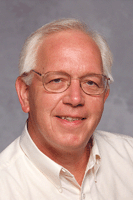Obituaries: Samuel P. Marin
September 24, 2008

Samuel P. Marin
Samuel P. Marin died of a massive coronary on May 25, 2008, while riding his bicycle. He was 59. He had worked at General Motors Research Laboratories since 1978, as a research mathematician and as a group leader.
Sam attended Saint Vincent College in Latrobe, Pennsylvania, where he received a BA in mathematics in 1970. After earning a master's degree in mathematics from Carnegie Mellon University, Sam joined the Navy and served as a naval officer. He taught mathematics at the U.S. Naval Nuclear Power School in Bainbridge, Maryland, until 1976; his leadership skills led to his appointment as director of the Mathematics Division in the school's training program.
On leaving the Nuclear Power School, Sam returned to Carnegie Mellon, where he received a doctorate in mathematics in 1978. He and his thesis adviser, Richard MacCamy, worked on the application of finite element analysis to exterior surface problems. Sam was also very much influenced by George Fix, with whom he published a paper on variational methods for underwater acoustics.
Sam carried his interest in acoustics with him when he joined the General Motors Research Laboratories in 1978, where he published papers dealing with ultrasound used in gauging and sensing. His initial work at GMR also resulted in mathematical papers on surface chemistry. As often happens in industrial applications of mathematics, Sam extended the breadth of his mathematical interests, which eventually included approximation theory, robotics, and computer-aided design; he published papers in each of these areas.
Sam received GM Charles L. McCuen Special Achievement Awards for robotic painting software and for a mathematics-based reactive maintenance staff estimator that uses real-time plant data. He was also awarded a patent for Innersurf, an innovative surface used in computer-aided design.
In 1992 Sam joined the ranks of management at GMR as head of the Mathematics Department, a post he held until GMR merged all departments into mission-oriented laboratories. In his last position, as manager of a lab group in manufacturing operations, Sam oversaw research on welding for which he and colleagues were awarded seven patents. Sam played a key role in establishing a General Motors collaborative research laboratory at Shanghai Jiao Tong University in China for advanced manufacturing processes.
Sam preceded me in joining General Motors Research Laboratories by several months. Because we had both attended small undergraduate colleges and remained attached to our alma maters, we immediately connected.
Sam's career at GMR reflected his intellectual approach to solving problems and a strong sense of duty and service to his colleagues. He had a quiet way and manner, but everyone listened to what he had to say. These qualities were abundantly evident in his contributions to the Institute for Mathematics and its Applications at the University of Minnesota, as a long-time member of the Industrial Advisory Board and, more recently, as a member of the Board of Governors, the IMA's principal external governing body.
"Sam provided a valuable perspective to the IMA," says Douglas Arnold, president-elect of SIAM and, until recently, director of the IMA. "He was involved in corporate R&D at the highest levels, but he also maintained a close connection to mathematical research, and had a strong sense of how even quite academic research could ultimately have a major impact on industry. I was a beneficiary of Sam's advice and support on many occasions. He was a wise man and a good one, and I valued his help very much."
Current IMA director Fadil Santosa looks back on 13 years of regular visits to GMR, where Sam introduced him to much of the interesting research being done at the lab. The two collaborated on two projects related to automobile manufacturing, both re-sulting in publications. Santosa credits Sam for encouraging him to apply to become director of the IMA.
"I really valued Sam's opinion and often sought advice from him," Santosa says. "Sam saw opportunities for mathematics in almost every aspect of the automotive industry. He understood his role at the IMA as someone who could bring mathematics to bear on challenges facing his industry, and as someone who could help enrich mathematical research by introducing industrial problems. Beyond programmatic ideas, Sam connected me to many researchers who eventually contributed to IMA's programs as speakers and workshop participants."
Again and again, in speaking of Sam, friends and colleagues mention his quiet and wise counsel.
Devotion, service, and lasting relationships permeated Sam's life. By far his strongest devotion was to his family. He is survived by Sheila, his wife of 37 � years, and their children, Erica Rupar and Samuel F. Marin. Sam resided in Oakland Township, Michigan, where his favorite activities were fly fishing, photography, riding his bicycle, and sailing with his family. Sam was unwaveringly proud of his family, and his joy in talking about his children was always evident.---David Field, General Motors Research Laboratories.

